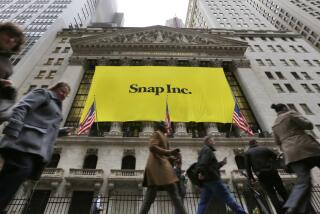Looking for Pennies From Heaven? Search for an ‘Angel’
- Share via
Many entrepreneurs still believe that professional venture capitalists provide seed money for most new businesses in America. But that is a myth, according to Robert J. Gaston, author of “Finding Private Venture Capital for Your Firm.”
In fact, Gaston contends that professional venture capitalists--who reject about 99% of the deals they consider--invest in only 2,100 of the 600,000 new businesses opening every year in the United States.
That means that most entrepreneurs are getting money from private investors or “business angels,” as Gaston calls them.
“Angels put almost six of every 10 dollars in very small firms with less than four employees and sales of under $150,000 per year,” Gaston said. He added that these business angels are scattered across the country and eager to invest in all kinds of businesses, not just those involved in high technology. Gaston bases his book on a five-year study of the actual experience of 435 such investors who invested $60 million between 1982 and 1987. The study was funded in part by the Small Business Administration.
Gaston, a banker and economist, estimates that each year 720,000 angels make 490,000 investments in 87,000 entrepreneurial ventures. That translates into $56 billion in risk capital.
And just who are Gaston’s angels? His composite angel is a 47-year-old white male with a college degree in business or engineering. He is a business owner with entrepreneurial experience and income of $90,000 a year. A typical angel has a median net worth of $750,000.
Unlike professional venture capitalists who seek a rate of return of at least 30%, Gaston’s angels generally sought a 22% return on their investment. Preferring to keep an eye on their money, they usually invested in companies within 50 miles of their homes.
On the receiving end is an entrepreneur who is typically a white male between 25 and 35 years old.
Contrary to another financial myth, Gaston says, angels do not limit their investments to high technology.
Now that you know where the money really comes from, how does an eager entrepreneur find his or her angels?
Word of mouth, happenstance and luck, says Frank Kilpatrick, a Manhattan Beach investment banker and financial consultant who specializes in helping companies write business plans and develop strategies to find money.
“Angel investors will usually have some degree of familiarity with the business or industry,” Kilpatrick said. “They feel they can contribute something tangible to the enterprise.”
To help entrepreneurs meet their angels, Kilpatrick co-founded the Stanford Entrepreneurial Forum--a group of Stanford Business School alumni who review business plans and invite new business owners to make presentations to potential investors.
He recommends that new business owners seek law and accounting firms that specialize in helping entrepreneurs, because the partners in such firms often have contacts in the business community.
One 32-year-old Southern California entrepreneur agreed to discuss his frustrating search for venture capital if his company’s name were not revealed. He said he is close to completing a financing arrangement and did not want to jeopardize its success.
The man perfectly fits Gaston’s definition of a hungry entrepreneur. For 10 years he worked at a major Southern California aerospace firm in a mid-level, high-technology job. Eager to start his own business, he began developing a computer-based product designed to perform a task now done by antiquated equipment. His product is aimed at a specific industry, and he believes that it provides a breakthrough solution to a problem.
About a year ago, he quit his job and moved into a tiny office behind his home. He wrote and rewrote a business plan before convincing one company that his new system would dramatically improve its operations. After several presentations and meetings, the company agreed to provide seed money in exchange for the privilege of buying the first system.
“We are looking for $1.1 million and we have been criticized because our needs are too small,” he said. “It might be easier to raise $30 million.”
After repeated rejections from professional venture capitalists, he began focusing his efforts on attracting business angels, mostly through personal contacts.
So far, he has raised an undisclosed amount from two such investors and one institution. And today, the fledgling company has a new office with five full-time and three part-time employees. He says the first prototype machine should be ready for demonstration by summer.
Looking back on his experience, he suggests first looking for money from friends and relatives. “Spend two days with your address book, writing down the name of everyone who may have money. Then contact them,” he advises.
And he cautions against paying people who promise to help you raise money. “I’d say, do not spend money to get money unless you are completely lost.”
While he is not interested in borrowing money from anyone who wants to take over his company, he says he is willing to take on an experienced investor who wants to help him run things: “It’s not how much money you get, but it’s who you get it from.”
Entrepreneurs interested in making presentations to the Stanford Entrepreneurial Forum should send two copies of their business plan to the Forum, P.O. Box 7861, Burbank, Calif., 91510.
Two good books about finding venture capital are “Finding Private Venture Capital for Your Firm,” by Robert J. Gaston and “The Arthur Young Guide to Raising Venture Capital,” by G. Steven Burrill and Craig T. Norback.
Gaston’s book is published by John Wiley & Sons, Business/Law/General Books division, 605 Third Ave., New York, N.Y. 10158-0012.
The Arthur Young book includes a list of venture capital firms and is published by Liberty House, a division of TAB Books Inc., Blue Ridge Summit, Pa. 17294-0214.
Change in Climate
The economic climate for small businesses declined slightly in the fourth quarter of 1988, despite a sharp increase in demand for goods and services, according to the American Express small business climate index.
The index is a quarterly measure of four factors affecting businesses with fewer than 100 employees: financing costs, demand for goods and services, operating costs and optimism. The optimism factor is based on a survey taken by a national association of independent business owners.
“The small business market is concerned about the prospect of inflation at this stage of the seven yearlong economic expansion,” said David Birch, co-chairman of the American Express Small Business Partnership.
He said operating costs rose 4.3% over the same period last year. Interest rates for commercial and industrial loans rose to 11.78% from 11.1%. But demand for small business products and services rose to an annualized rate of 7.8%, almost double the third quarter’s 4% increase.
More to Read
Inside the business of entertainment
The Wide Shot brings you news, analysis and insights on everything from streaming wars to production — and what it all means for the future.
You may occasionally receive promotional content from the Los Angeles Times.










